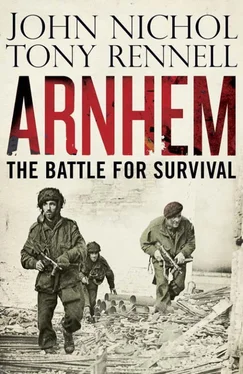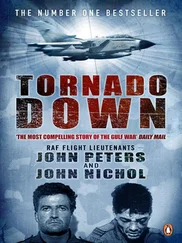Two hundred miles away, across the North Sea, thousands of men were preparing to liberate Arnhem. The training was behind them, the briefings had been given. Now it was a case of maintaining morale and comradeship at a pitch where they would go into battle without flinching. Bombardier Leo Hall, a radio signaller, and his mates were let out of camp in Lincolnshire to go to the cinema. He could never recall anything about the film they saw, not even its name or who was in it, but the blistering march back to barracks, with full-throated voices belting out the bawdy words of ‘The Big Flywheel’ in unison like naughty boys – ‘Round and round went the bloody great wheel/ In and out went the p**** of steel’ – released some of the tension, took their thoughts away from what lay ahead. Paratrooper James Sims, on the other hand, well remembered what he’d watched on the silver screen that night – Hellzapoppin’ , an American song-and-dance funny starring comedians Ole Olsen and Chic Johnson – and thought it ‘the funniest film I’d ever seen’. [7] Arnhem Spearhead , by James Sims. Imperial War Museum, 1978, and Sphere Books, 1989.
He also remembered the rows of military police lining the auditorium to make sure no one got cold feet and tried to do a runner. Near his base, another paratrooper, Andy Milbourne, downed pints in the pub as his platoon went through the extensive repertoire of ghoulish para songs, from ‘He Ain’t Gonna Jump No More’ to ‘Three Cheers for the Next Man to Die’. Beer and bravado steadied the nerves as the 1st Airborne Division prepared to leapfrog into Europe.
Airborne troops represented one of the Second World War’s ground-breaking new weapons. Technologically, this global conflict was revolutionary in many ways – the long-distance bomber, submarines, rockets and the atom bomb among them. But the one device that really came into its own was the parachute, floating down from the skies with an armed, aggressive infantryman on the end of it. Germany led the way with its Fallschirmjäger , parachutists dropping behind the lines to great effect in Denmark, Norway, the Netherlands and Crete. Ironically, the heavy losses sustained in Crete persuaded Hitler that airborne attacks were over-extravagant and unnecessary and he put a stop to their widespread use. But Britain, by then, had seized on the airborne idea, egged on by the personal intervention of prime minister Winston Churchill, who delighted in shock tactics to bamboozle an enemy and take him by surprise.
The Parachute Regiment was founded as a small, elite force to carry out hit-and-run raids, then expanded (though still very much an elite) to become a full-on attacking force, a spearhead to thrust into the heart of the enemy, ahead of the main force. The training was tough, the risk and adrenaline levels high. Only the bravest need apply. Only the best were recruited. To be qualified to wear the red beret set a man apart. ‘We were lauded as super-fit and super-daring,’ recalled Leo Hall. ‘We turned heads in our comings and goings. Though generally from working-class backgrounds, we became an aristocracy.’ As Allied paras, [8] The use (or misuse) of the words ‘paras’ and ‘paratroopers’ can still cause fighting to break out in the ranks. In the text, we have opted for the generic definition where necessary, for ease of reading.
both British and American, led the invasions of North Africa, Sicily and Italy, they proved their worth as impact players, making a vital difference to the outcome of battle. They also had back-up in the 1st Airlanding Brigade, whose gliders provided an additional means of back-door entry into enemy territory. Towed to enemy air space by ‘tugs’ and then cut loose to coast down, they could carry not only infantry but heavy equipment as well, including jeeps and small tanks. Once on the ground, paratroopers generally had just their own two feet for transport. Gliders were a means to increased mobility – to hitting further and faster. The men and machines they carried were, in effect, the airborne cavalry.
At the D-Day landings, troops of the 6th Airborne, one of the British army’s two airborne divisions, were in the vanguard. Just before the Allied infantry stormed on to the beaches of Normandy, parachutists dropped inland to knock out the gun batteries which dominated the cliff-tops. Meanwhile, brilliantly flown gliders landed just yards from a canal bridge vital to the advance inland, enabling the troops on board to capture it. Strategically, these were vital missions. If either had failed, so too might the entire enterprise. There was every chance of the Allied army being pushed back into the sea. The men of the 6th demonstrated in full the impact of airborne on the modern battlefield. Three and a half months later, there seemed no reason to doubt that a similar smash-and-grab operation could be repeated, with equally devastating results, this time to seize bridges over the wide and muddy waters of the Rhine in the Netherlands.
The plan was the brainchild of Montgomery – the hero of El Alamein and the Western Desert – and was remarkably daring for this habitually meticulous military planner. But he had a point to prove. His recent promotion from general to field marshal was the clue to his state of mind – the enhanced rank was a personal and political sop concocted by Churchill and the king to divert attention from the fact that he had lost overall control of the land forces in Europe to the American supreme commander, General Dwight ‘Ike’ Eisenhower. He was also losing the argument among the Allies about how best to defeat Hitler. Eisenhower wanted a broad-front attack on Germany, his armies ranged from north to south and advancing in tandem as they pushed towards the Rhine, sweeping all before them. But Monty, contemptuous of the Americans – he thought Eisenhower pedestrian and unfit to command – believed this approach slow and cumbersome. Every yard would be a battle. The Germans would have time and opportunity to re-group their defences. Certain of his own pre-eminence as a military leader, his preference now was for a single rapid strike, concentrating forces on one weak spot and thundering through the enemy lines. ‘One really powerful and full-blooded thrust towards Berlin is likely to get there and thus end the German war,’ he lectured Eisenhower in a communiqué at the beginning of September. ‘[But] if we attempt a compromise solution and split our resources so that no thrust is full-blooded, we will prolong the war.’ [9] The Memoirs of Field Marshal Montgomery . Collins, 1958, and Pen and Sword Military, 2010.
It was not just his belief in the superiority of his own military prowess that led him to this conclusion. He picked up on the sense of urgency that had developed among the Allies, and especially the British public, since the euphoria of D-Day. With hindsight, we know that final victory over Germany was close, just seven months away in fact. It didn’t feel that way at the time. For war-weary armies and civilians back home, the desire to see a glimmer of light was immense. Britain had been at war since September 1939, and the conflict had already outdistanced the 1914–18 War to End All Wars, by many months. London was under intense aerial bombardment again; sirens wailed and for the first time since the Blitz of 1940–41, women and children were dying in the rubble of their own homes, first from doodlebugs, Hitler’s revenge weapons, and then, the latest horror, V2 rockets. Morale – which should have been sky-high with the victories in Europe – was lower than it had been for years. An exhausted air hung over the country.
The thought of another new year opening with the country still at war was almost intolerable. But wishful thinking would not win battles and hasten victory. Privately, Churchill admitted that neither the German army nor the German people were about to roll over. ‘It is as likely that Hitler will be fighting on January 1 as that he will collapse before then,’ he wrote in a memo on 8 September. Nonetheless, to counter the gloomy prognostications, there was an outbreak of wild, ‘if only’ optimism that it could indeed all be over by Christmas, particularly among the men now briefed for the major assault they were led to believe would do the job – Operation Market Garden. ‘We thought the Germans were on their way out,’ one recalled. ‘They were being pushed back so fast that we would be that final little pin that opened everything up.’ [10] Alan Kettley, Official intelligence debrief, October 1944 (Airborne Assault, Imperial War Museum, Duxford), and JN interview, 2010.
Читать дальше












